-
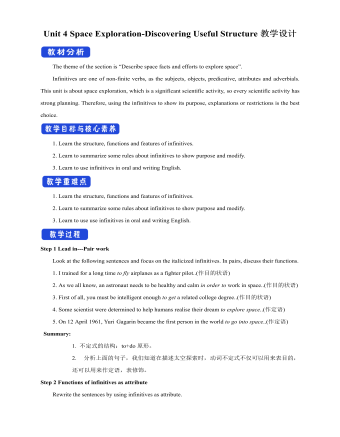
新人教版高中英语必修3Unit 4 Space Exploration-Discovering Useful Structure教学设计
The theme of the section is “Describe space facts and efforts to explore space”. Infinitives are one of non-finite verbs, as the subjects, objects, predicative, attributes and adverbials. This unit is about space exploration, which is a significant scientific activity, so every scientific activity has strong planning. Therefore, using the infinitives to show its purpose, explanations or restrictions is the best choice.1. Learn the structure, functions and features of infinitives.2. Learn to summarize some rules about infinitives to show purpose and modify.3. Learn to use infinitives in oral and writing English. 1. Learn the structure, functions and features of infinitives.2. Learn to summarize some rules about infinitives to show purpose and modify.3. Learn to use use infinitives in oral and writing English.Step 1 Lead in---Pair workLook at the following sentences and focus on the italicized infinitives. In pairs, discuss their functions. 1. I trained for a long time to fly airplanes as a fighter pilot..(作目的状语)2. As we all know, an astronaut needs to be healthy and calm in order to work in space..(作目的状语)3. First of all, you must be intelligent enough to get a related college degree..(作目的状语)4. Some scientist were determined to help humans realise their dream to explore space..(作定语)5. On 12 April 1961, Yuri Gagarin became the first person in the world to go into space..(作定语)Summary:1. 不定式的结构:to+do原形。2. 分析上面的句子,我们知道在描述太空探索时,动词不定式不仅可以用来表目的,还可以用来作定语,表修饰。
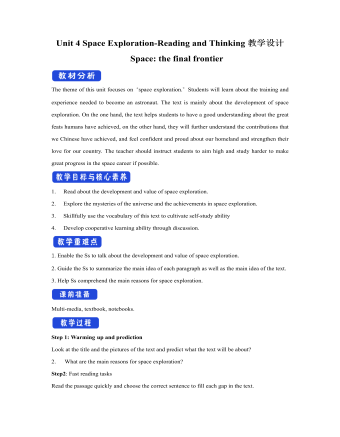
新人教版高中英语必修3Unit 4 Space Exploration-Reading and Thinking教学设计二
The theme of this unit focuses on “space exploration.” Students will learn about the training and experience needed to become an astronaut. The text is mainly about the development of space exploration. On the one hand, the text helps students to have a good understanding about the great feats humans have achieved, on the other hand, they will further understand the contributions that we Chinese have achieved, and feel confident and proud about our homeland and strengthen their love for our country. The teacher should instruct students to aim high and study harder to make great progress in the space career if possible.1. Read about the development and value of space exploration.2. Explore the mysteries of the universe and the achievements in space exploration.3. Skillfully use the vocabulary of this text to cultivate self-study ability 4. Develop cooperative learning ability through discussion.1. Enable the Ss to talk about the development and value of space exploration.2. Guide the Ss to summarize the main idea of each paragraph as well as the main idea of the text.3. Help Ss comprehend the main reasons for space exploration. Multi-media, textbook, notebooks.Step 1: Warming up and predictionLook at the title and the pictures of the text and predict what the text will be about?2. What are the main reasons for space exploration?
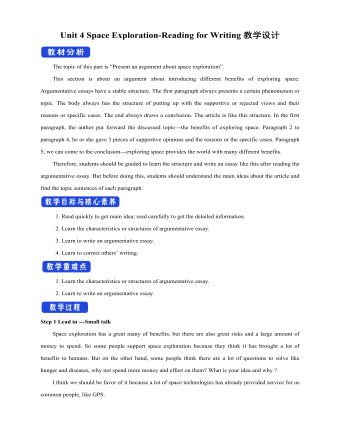
新人教版高中英语必修3Unit 4 Space Exploration-Reading for Writing教学设计二
⑦在我看来, 探索太空是值得的。As far as I am concerned, it is worthwhile to explore the space.Step 10 Writing---draftRecently, students in our class have had heated a discussion on whether space is worth exploring. Students hold different ideas about it.30% of us think space exploration is not worthwhile. They think space is too far away from us and our daily life and is a waste of money. And the money spent on space exploration can be used to solve the earth’s problems such as starvation and pollution.On the other hand,70% think space is worth exploring because we have benefited a lot from it,such as using satellites for communication and weather forecast. What’s more,with further space research,we may solve the population problem by moving to other planets one day. Also,space research will enable us to find new sources to solve the problem of energy shortages on the earth.As far as I am concerned, it is worthwhile to explore the space. Not only can it promote the development of society but also enrich our life. Step 11 Pair workExchange drafts with a partner. Use this checklist to help your partner revise his/her draft.1.Does the writer explain why he/she changed/wanted to change?2.Does the writer tell how the changes have improved or will improve his/her life?3.Is the text well-organised?4.Does the writer use words and expressions to show similarities and differences?5.Are there any grammar or spelling errors?6.Does the writer use correct punctuation?
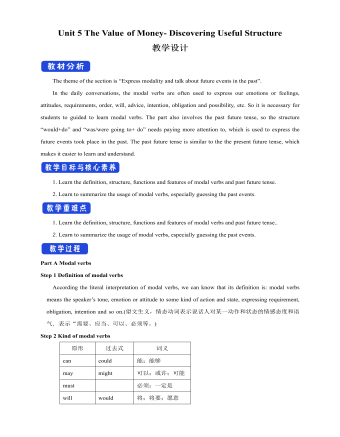
新人教版高中英语必修3Unit 5 The Value of Money- Discovering Useful Structure教学设计
Step 3 Meaning1. 过去将来时表示从过去某一时间来看将要发生的动作或存在的状态, 常用在宾语从句中。一般由“would/should +动词原形”构成。She hoped that they would meet again someday. 她希望将来有一天他们能再见面。2. was/were going to+动词原形: 表示过去将要发生或很有可能发生的动作, 常用于口语中, 表示预言、意图或者打算等。He was going to start work the following week. 他打算下星期开始工作。3. was/were about to do: 常用来表示即将发生的动作, “刚要/正要做……”。注意该结构不与任何时间状语连用。I felt that something terrible was about to happen. 我感到某种可怕的事情即将发生。4.was/were to do: 表示“曾计划做某事”, 如果表示“本来计划做某事, 动作没实现”, 则需用 “was/were to have done”。She said she was to have told me about the accident. 她说她本来想告诉我关于事故的事。5.Start, go, come, leave, see, meet等动词的过去进行时: 表示就过去某一时刻而言即将发生的动作。She was coming later. 她随后就来。I had just put on my overcoat and was leaving to visit a friend of mine. 我刚穿上外套要去看我的一个朋友。
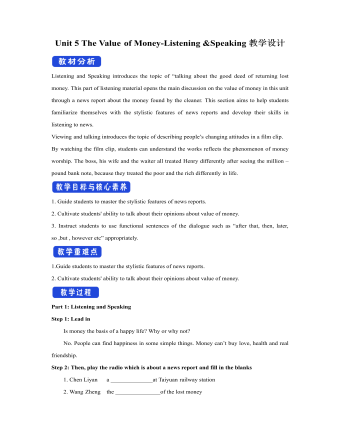
新人教版高中英语必修3Unit 5 The Value of Money-Listening &Speaking教学设计
Step 4: Listen again and decide if the following statements are true (T) or false (F).1 It was the first time Chen Liyan's story was reported. T口 F口2 Chen found 10,000 yuan in a small plastic bag in Taiyuan railway station口 F口3 Wang Zheng apologized to Chen because he couldn't offer her more money. T口 F口4 Chen took out a large loan to cure her daughter, T口 F口5 Wang set up a fundraising website for Chen's daughter after Chen told him about her situation. T口 F口Step 5:After listening, discuss the questions.1 What kind of person do you think Chen Liyan is?Chen Liyan is generous and honest because she returned a large sum of money to the owner.2 Did Chen return the money because she didn't need it?No. She returned the money because it was the right thing to do. Evidence for this is that she refused to accept the reward money because she felt that it had not been earned. 3 Is it common for people to do what Chen did?It depends on the culture. In some countries it is quite common to return money that has been found. In other countries, people believe "Finders are keepers!" 4 How did Wang Zheng feel about the return of his money?He must have been very happy and relieved to have gotten his money back. We know this because he thanked Chen repeatedly and even offered her a reward.5 Why did Ma Dongbao tell Wang about Chen's family?He must have had great sympathy for Chen and her daughter and wanted to help them.'We know this because he arranged help for them. 6 How did the news reporter feel about Chen's actions?The news reporter felt that it showed that money wasn't the most important thing in life. We know this because the reporter told us that this is what Chen believes. and then said, “that's a great attitude to take."
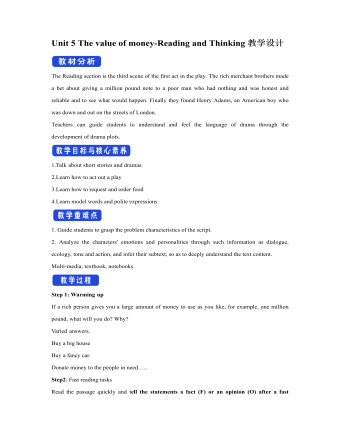
新人教版高中英语必修3Unit 5 The value of money-Reading and Thinking教学设计二
? Could you offer me some kind of work here?? I don’t want your charity, I just want an honest job.? Careless: I landed in Britain by accident.Step 7:Consolidation.? Find Henry? Roderick and Oliver were I .making a bet when they saw Henry, a poor young man. ? Know Henry? About a month ago, Henry was sailing and later he found himself carried out to sea by a strong wind. Fortunately, he 2.was spotted by a ship. And it was the ship that brought him to 3.England? Offer money to Henry ? Oliver and Roderick gave Henry a letter and told him that there was money in it. They 4.persuaded him to accept it, and made him 5.promise that it wouldn't be opened until 2 o'clock.Step 8:Language pointsa large amount of: a large quantity of; a great deal ofe.g. They bought a large amount of furniture before they moved their new house.make a bet: make an arrangement to risk money, etc. on an event of which the result is doubtful.e.g. We made a bet on the result of the match.permit sb to do something: allow somebody to do somethinge.g. My mother doesn’t permit me to ride in the street after it rained.by accident: as a result of chancee.g. I only found it by accident.stare at: look at somebody or something with the eyes wide open in a fixed gaze( in astonishment, wonder, fear, etc)to be honest: to tell you the truth; to be franke.g. To be honest, I don’t think we have a chance of winning.Step7 Homework:What do you think will happen to Henry? Will the bank-note help him or get him into trouble?
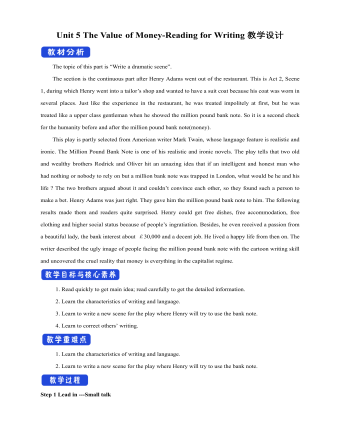
新人教版高中英语必修3Unit 5 The Value of Money-Reading for Writing教学设计二
2. 您能看到, 我头发太长了。You can see that my hair is much too long.3. 无论什么时候, 只要您想回来就回来。Please come back whenever you want.4. 您仅有很少的头发要理! You only have too little hair to cut !5. 为您服务是我的荣幸!It is my honour to serve you!Step 9 Writing(Henry is walking down the street when he sees a sign for a place that cuts hair. He decides to have it cut. )H=Henry B=BarberH: Good afternoon, I’d like to have my hair cut, if I may. (The barber looks at Henry’s hair and continues cutting another man’s hair. ) Er, I’d really like a haircut. As you can see it’s much too long. B: (in a rude manner) Yes, I can see that. Indeed, I can. H: Fine, well, I’ll have a seat then. (He sits in one of the barber’s chairs. The barber turns to look at Henry. )B: It’s quite expensive here, you know! Are you sure you can afford it?H: Yes. I think so. (After his hair is cut, the barber tells Henry how much he must pay. Henry shows the barber the bank note. )B: Why Mr. . . (looks shocked)H: Adams. Henry Adams. I’m sorry. I don’t have any change. B: Please don’t worry! (wearing a big smile) Nothing to worry about! Nothing at all! Please come back whenever you want, even if you only have too little hair to cut! It will be my honour to serve you!Step 10 Pair workExchange drafts with a partner. Use this checklist to help your partner revise his/her draft.1. Are all the elements of a play included and in good order ?2. Do the character use suitable language ?3. Are the stage directions clear and useful ?4. Is the plot clear and exciting enough ?
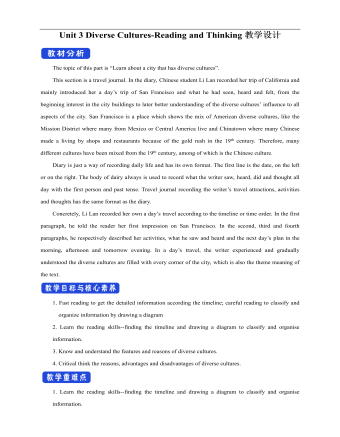
新人教版高中英语必修3Unit 3 Diverse Cultures-Reading and Thinking教学设计
Discuss these questions in groups.Q1: Have you ever been to a place that has a diverse culture ? What do you think about the culture diversity ?One culturally diverse place that I have been to is Harbin, the capital city of Heilongjiang Province. I went there last year with my family to see the Ice and Snow Festival, and I was amazed at how the culture as different to most other Chinese cities. There is a big Russian influence there, with beautiful Russian architecture and lots of interesting restaurants. I learnt that Harbin is called “the Oriental Moscow” and that many Russians settled there to help build the railway over 100 years ago.Q2: What are the benefits and challenges of cultural diversity ?The benefits: People are able to experience a wide variety of cultures, making their lives more interesting, and it can deepen the feelings for our national culture, it is also helpful for us to learn about other outstanding culture, which helps improve the ability to respect others. The challenges: People may have trouble communicating or understanding each other, and it may lead to disappearance of some civilizations and even make some people think “The western moon is rounder than his own.”Step 7 Post reading---RetellComplete the passage according to the text.Today, I arrived back in San Francisco, and it feels good (1) _____(be) back in the city again. The city succeeded in (2)_________ (rebuild) itself after the earthquake that (3)________ (occur) in 1906, and I stayed in the Mission District, enjoying some delicious noodles mixed with cultures. In the afternoon, I headed to a local museum (4)____ showed the historical changes in California. During the gold rush, many Chinese arrived, and some opened up shops and restaurants in Chinatown to earn a (5)_____ (live). Many others worked on (6)______ (farm), joined the gold rush, or went to build the railway that connected California to the east. The museum showed us (7)____ America was built by immigrants from (8)________ (difference) countries and cultures. In the evening, I went to Chinatown, and ate in a Cantonese restaurant that served food on (9)________(beauty) china plates. Tomorrow evening, I’m going to (10)__ jazz bar in the Richmond District. 答案:1. to be 2. rebuilding 3. occurred 4. that 5.living6. farms 7.how 8. different 9. beautiful 10. a
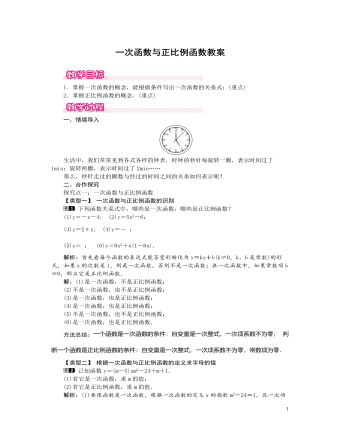
北师大初中数学八年级上册一次函数与正比例函数1教案
煤的价格为400元/吨,生产1吨甲产品除需原料费用外,还需其他费用400元,甲产品每吨售价4600元;生产1吨乙产品除原料费用外,还需其他费用500元,乙产品每吨售价5500元.现将该矿石原料全部用完,设生产甲产品x吨,乙产品m吨,公司获得的总利润为y元.(1)写出m与x的关系式;(2)写出y与x的函数关系式.(不要求写自变量的取值范围)解析:(1)因为矿石的总量一定,当生产的甲产品的数量x变化时,那么乙产品的产量m将随之变化,m和x是动态变化的两个量;(2)题目中的等量关系为总利润y=甲产品的利润+乙产品的利润.解:(1)因为4m+10x=300,所以m=150-5x2.(2)生产1吨甲产品获利为4600-10×200-4×400-400=600(元);生产1吨乙产品获利为5500-4×200-8×400-500=1000(元).所以y=600x+1000m.将m=150-5x2代入,得y=600x+1000×150-5x2,即y=-1900x+75000.方法总结:根据条件求一次函数的关系式时,要找准题中所给的等量关系,然后求解.
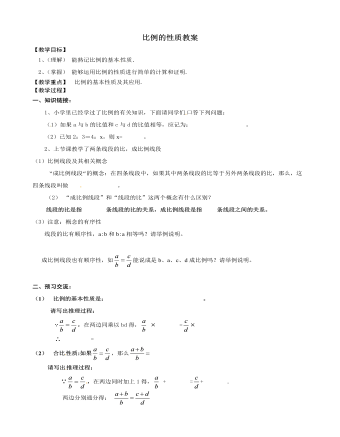
北师大初中数学九年级上册比例的性质2教案
请写出 推理过程:∵ ,在两边同时加上1得, + = + .两边分别通分得: 思考:请仿照上面的方法,证明“如果 ,那么 ”.(3) 等比性质:猜想 ( ),与 相等吗?能 否证明你的猜想?(引导学生从上述实例中找出证明方法)等比性质:如果 ( ),那么 = .思考:等比性质中,为什么要 这个条件?三、 巩固练习:1.在相同时刻的物高与影长成比例,如果一建筑在地面上影长为50米,高为1.5米的测竿的影长为2.5米 ,那么,该建筑的高是多少米?2.若 则 3.若 ,则 四、 本课小结:1.比例的基本性质:a:b=c:d ;2. 合比性质:如果 ,那么 ;3. 等比性质:如果 ( ),五、 布置作业:课本习题4.2
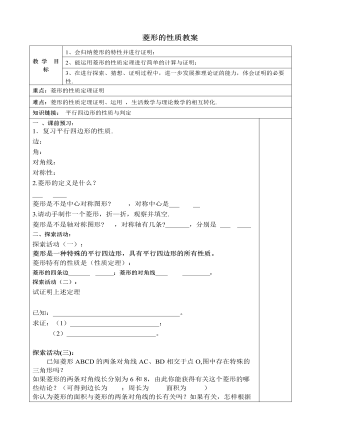
北师大初中数学九年级上册菱形的性质2教案
1. _____________________________________________2. _____________________________________________你会计算菱形的周长吗?三、例题精讲例1.课本3页例1例2.已知:在菱形ABCD中,对角线AC、BD相交于点O,E、F、G、H分别是菱形ABCD各边的中点,求证:OE=OF=OG=OH.四、课堂检测:1.已知四边形ABCD是菱形,O是两条对角线的交点,AC=8cm,DB=6cm,菱形的边长是________cm.2.菱形ABCD的周长为40cm,两条对角线AC:BD=4:3,那么对角线AC=______cm,BD=______cm.3.若菱形的边长等于一条对角线的长,则它的一组邻角的度数分别为 4.已知菱形的面积为30平方厘米,如果一条对角线长为12厘米,则别一条对角线长为________厘米.5.菱形的两条对角线把菱形分成全等的直角三角形的个数是( ).(A)1个 (B)2个 (C)3个 (D)4个6.在菱形ABCD中,CE⊥AB,E为垂足,BC=2,BE=1,求菱形的周长和面积
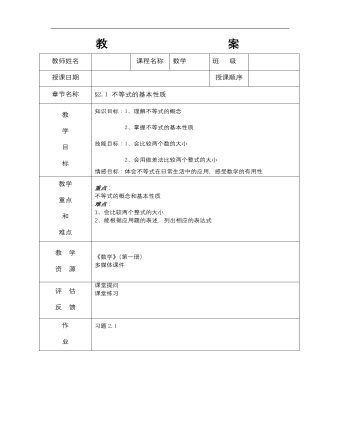
【高教版】中职数学基础模块上册:2.1《不等式的基本性质》教案设计
教师姓名 课程名称数学班 级 授课日期 授课顺序 章节名称§2.1 不等式的基本性质教 学 目 标知识目标:1、理解不等式的概念 2、掌握不等式的基本性质 技能目标:1、会比较两个数的大小 2、会用做差法比较两个整式的大小 情感目标:体会不等式在日常生活中的应用,感受数学的有用性教学 重点 和 难点 重点: 不等式的概念和基本性质 难点: 1、会比较两个整式的大小 2、能根据应用题的表述,列出相应的表达式教 学 资 源《数学》(第一册) 多媒体课件评 估 反 馈课堂提问 课堂练习作 业习题2.1课后记
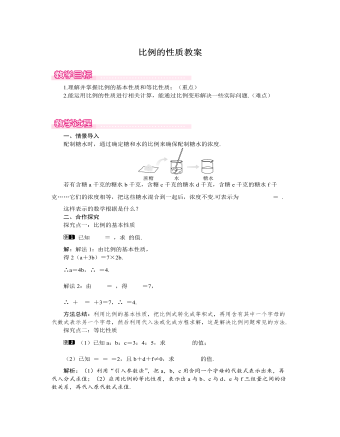
北师大初中数学九年级上册比例的性质1教案
若a,b,c都是不等于零的数,且a+bc=b+ca=c+ab=k,求k的值.解:当a+b+c≠0时,由a+bc=b+ca=c+ab=k,得a+b+b+c+c+aa+b+c=k,则k=2(a+b+c)a+b+c=2;当a+b+c=0时,则有a+b=-c.此时k=a+bc=-cc=-1.综上所述,k的值是2或-1.易错提醒:运用等比性质的条件是分母之和不等于0,往往忽视这一隐含条件而出错.本题题目中并没有交代a+b+c≠0,所以应分两种情况讨论,容易出现的错误是忽略讨论a+b+c=0这种情况.三、板书设计比例的性质基本性质:如果ab=cd,那么ad=bc如果ad=bc(a,b,c,d都不等于0),那么ab=cd等比性质:如果ab=cd=…=mn(b+d+…+n≠0), 那么a+c+…+mb+d+…+n=ab经历比例的性质的探索过程,体会类比的思想,提高学生探究、归纳的能力.通过问题情境的创设和解决过程进一步体会数学与生活的紧密联系,体会数学的思维方式,增强学习数学的兴趣.
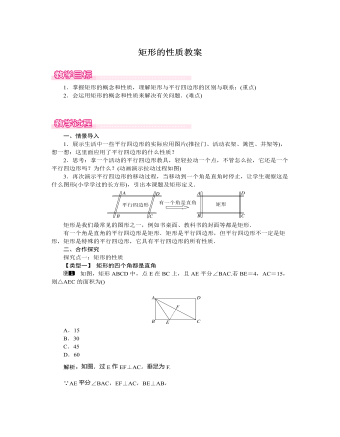
北师大初中数学九年级上册矩形的性质1教案
解:∵四边形ABCD是矩形,∴AD∥BC,∠A=90°,∴∠2=∠3.又由折叠知△BC′D≌△BCD,∴∠1=∠2.∴∠1=∠3.∴BE=DE.设BE=DE=x,则AE=8-x.∵在Rt△ABE中,AB2+AE2=BE2,∴42+(8-x)2=x2.解得x=5,即DE=5.∴S△BED=12DE·AB=12×5×4=10.方法总结:矩形的折叠问题是常见的问题,本题的易错点是对△BED是等腰三角形认识不足,解题的关键是对折叠后的几何形状要有一个正确的分析.三、板书设计矩形矩形的定义:有一个角是直角的平行四边形 叫做矩形矩形的性质四个角都是直角两组对边分别平行且相等对角线互相平分且相等经历矩形的概念和性质的探索过程,把握平行四边形的演变过程,迁移到矩形的概念与性质上来,明确矩形是特殊的平行四边形.培养学生的推理能力以及自主合作精神,掌握几何思维方法,体会逻辑推理的思维价值.
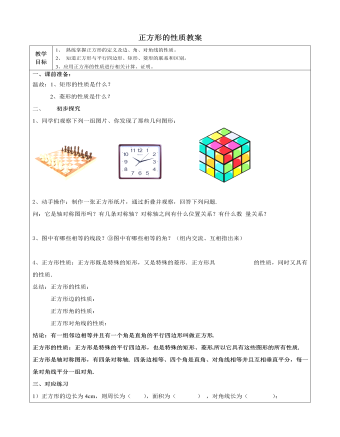
北师大初中数学九年级上册正方形的性质2教案
1)正方形的边长为4cm,则周长为( ),面积为( ) ,对角线长为( );2))正方形ABCD中,对角线AC、BD交于O点,AC=4 cm,则正方形的边长为( ), 周长为( ),面积为( )3)在正方形ABCD中,AB=12 cm,对角线AC、BD相交于O,OA= ,AC= 。4) 1、正方形具有而矩形不一定具有的性质是( ) A、四个角相等 B、对角线互相垂直平分 C、对角互补 D、对角线相等. 5)、正方形具有而菱形不一定具有的性质( ) A、四条边相等 B对角线互相垂直平分 C对角线平分一组对角 D对角线相等. 6)、正方形对角线长6,则它的面积为_________ ,周长为________. 7)、顺次连接正方形各边中点的小正方形的面积是原正方形面积的( )A.1/2 B.1/3 C.1/4 D.1/ 5四:范例讲解:1、(课本P21例1)学生自己阅读课本内容、注意证明过程的书写2、 如图,分别以△ABC的边AB,AC为一边向外画正方形AEDB和正方形ACFG,连接CE,BG.求证:BG=CE

数据的整理教案教学设计
一、课前准备师:同学们想一想,你同父母一起去商店买衣服时,衣服上的号码都有哪些,标志是什么?学生:我看到有些衣服上标有M、S、L、XL、XXL等号码.但我不清楚代表的具体范围,适合什么人穿,但肯定与身高、胖瘦有关.师:这位同学很善动脑,也爱观察.S代表最小号,身高在150~155cm的人适合穿S号.M号适合身高在155~160cm的人着装……厂家做衣服订尺寸也并不是按所有人的尺寸定做,而是按某个范围分组批量生产.你觉得这种生产方法有什么优点?学校要为同学们订制校服,为此小明调查了他们班50名同学的身高,结果(单位cm).如下

北师大版初中数学九年级上册反比例函数的图象与性质说课稿
问题6:观察刚才所画的图象我们发现反比例函数的图象有两个分支,那么它的分布情况又是怎么样的呢?在这一环节中的设计:(1) 引导学生对比正比例函数图象的分布,启发他们主动探索反比例函数的分布情况,给学生充分考虑的时间;(2) 充分运用多媒体的优势进行教学,使用函数图象的课件试着任意输入几个k的值,观察函数图象的不同分布,观察函数图象的动态演变过程。把不同的函数图象集中到一个屏幕中,便于学生对比和探究。学生通过观察及对比,对反比例函数图象的分布与k的关系有一个直观的了解;(3) 组织小组讨论来归纳出反比例函数的一条性质:当k>0时,函数图象的两支分别在第一、三象限内;当k<0时,函数图象的两支分别在第二、四象限内。
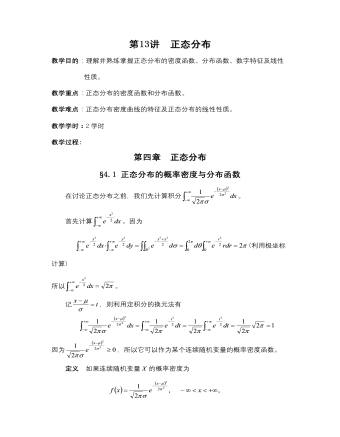
【高教版】中职数学拓展模块:3.5《正态分布》教学设计
教学目的:理解并熟练掌握正态分布的密度函数、分布函数、数字特征及线性性质。教学重点:正态分布的密度函数和分布函数。教学难点:正态分布密度曲线的特征及正态分布的线性性质。教学学时:2学时教学过程:第四章 正态分布§4.1 正态分布的概率密度与分布函数在讨论正态分布之前,我们先计算积分。首先计算。因为(利用极坐标计算)所以。记,则利用定积分的换元法有因为,所以它可以作为某个连续随机变量的概率密度函数。定义 如果连续随机变量的概率密度为则称随机变量服从正态分布,记作,其中是正态分布的参数。正态分布也称为高斯(Gauss)分布。
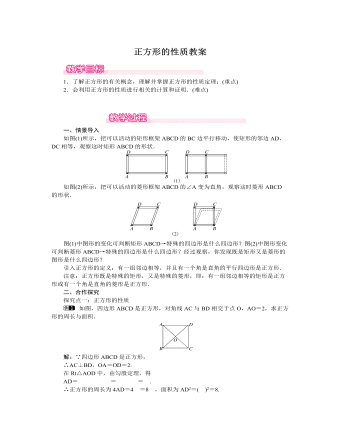
北师大初中数学九年级上册正方形的性质1教案
在Rt△ABC中,AC=AB2+BC2=12+12=2(cm),∴FC=AC-AF=2-1(cm),∴BE=2-1(cm).方法总结:正方形被对角线分成4个等腰直角三角形,因此在正方形中解决问题时常用到等腰三角形的性质与直角三角形的性质.【类型三】 利用正方形的性质证明线段相等如图,已知过正方形ABCD的对角线BD上一点P,作PE⊥BC于点E,PF⊥CD于点F,求证:AP=EF.解析:由PE⊥BC,PF⊥CD知四边形PECF为矩形,故有EF=PC,这时只需说明AP=CP,由正方形对角线互相垂直平分可知AP=CP.证明:连接AC,PC,如图.∵四边形ABCD为正方形,∴BD垂直平分AC,∴AP=CP.∵PE⊥BC,PF⊥CD,∠BCD=90°,∴四边形PECF为矩形,∴PC=EF,∴AP=EF.方法总结:(1)在正方形中,常利用对角线互相垂直平分证明线段相等;(2)无论是正方形还是矩形,经常连接对角线,这样可以使分散的条件集中.
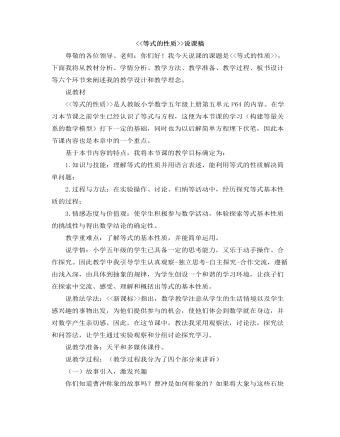
小学数学人教版五年级上册《等式的性质》说课稿
说教材>是人教版小学数学五年级上册第五单元P64的内容。在学习本节课之前学生已经认识了等式与方程,这便为本节课的学习(构建等量关系的数学模型)打下一定的基础,同时也为以后解简单方程埋下伏笔,因此本节课内容也是本章中的一个重点。基于本节内容的特点,我将本节课的教学目标确定为:1.知识与技能:理解等式的性质并用语言表述,能利用等式的性质解决简单问题;2.过程与方法:在实验操作、讨论、归纳等活动中,经历探究等式基本性质的过程;3.情感态度与价值观:使学生积极参与数学活动,体验探索等式基本性质的挑战性与得出数学结论的确定性。教学重难点:了解等式的基本性质,并能简单运用。说学情:小学五年级的学生已具备一定的思考能力,又乐于动手操作、合作探究。因此教学中我引导学生认真观察-独立思考-自主探究-合作交流,遵循由浅入深,由具体到抽象的规律,为学生创设一个和谐的学习环境,让孩子们在探索中交流、感受、理解和概括出等式的基本性质。





















